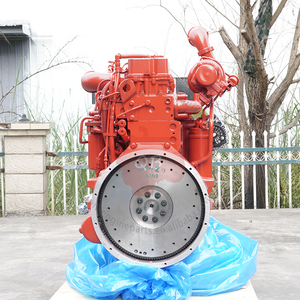(9616 products available)

























































































































































































































The Cummins ISL engine offers a range of long-lasting and dependable diesel and natural gas engines built for smooth and quiet operation. The Cummins ISL engines are used in heavy-duty trucks, buses, vocational, and special vehicles. They are categorized into 4 main types based on their specifications and features. Read on to discover the types of Cummins ISL engines and their specifications.
ISL9 Engine
The Cummins ISL9 engine is designed for commercial and heavy-duty applications. It has a displacement of 8.9 liters and is used where more power and torque are needed. The ISL9 engine has a power range of 260 to 450 horsepower and a torque range of 850 to 1450 lb-ft. Also, it has a compact design that makes it easy to install and maintain.
ISL-G Engine
The Cummins ISL-G engine is a natural gas engine. It is designed to use compressed natural gas (CNG) or liquefied natural gas (LNG) as fuel. The ISL-G engine delivers cleaner emissions compared to diesel engines. The Cummins ISL-G engine is used in buses, trucks, and other commercial vehicles where emissions are a key concern.
ISL B6.7 Engine
The Cummins ISL B6.7 engine is a diesel engine. It is commonly used in vocational applications such as construction, agriculture, and forestry. The ISL B6.7 engine has a power range of 200 to 350 horsepower. Also, it has a compact design and a high-power density, making it suitable for various applications.
ISL Euro 6 Engine
The Cummins ISL Euro 6 engine is designed to meet the Euro 6 emissions standards. It has advanced emissions control technologies such as selective catalytic reduction (SCR) and exhaust gas recirculation (EGR). The Cummins ISL Euro 6 engine is used in buses and trucks in areas where strict emissions regulations are in place.
The Cummins ISL engine is a highly specialized internal combustion engine with several specifications that make it a unique and powerful engine.
Displacement
The Cummins ISL engine has a total displacement of 8.9 liters (or 540 cubic inches). It has the capacity to draw in and compress a large amount of air, which results in the production of a high amount of power and torque.
Cylinders
The Cummins ISL engine contains six cylinders that are arranged in a line. Each cylinder works together during the combustion process to produce power and provide a smooth and balanced operation.
Power Output
The Cummins ISL engine has a power output range of 260 to 450 horsepower. This power output makes the engine highly suitable for demanding and heavy-duty applications.
Torque
The Cummins ISL engine is characterized by its high torque output that ranges from 660 to 1,250 lb-ft. The high torque offers better acceleration and responsiveness, making it easier to pull heavy loads and drive on steep inclines.
Fuel System
The Cummins ISL engine has a high-pressure common rail fuel injection system. This system optimizes fuel delivery and atomization, which results in better combustion, improved efficiency, and reduced emissions.
Cooling System
The Cummins ISL engine has an effective and efficient cooling system. The cooling system contains a thermostat, water pump, and engine coolant. The cooling system helps in maintaining a consistent temperature during operation and prevents overheating.
Emission Standards
The Cummins ISL engine is designed and manufactured to comply with strict emission standards. The engine incorporates several advanced technologies to reduce emissions, such as exhaust aftertreatment systems and selective catalytic reduction.
The Cummins ISL engine requires proper and regular maintenance to ensure reliability, efficiency, and durability. Here are some general maintenance tips:
It's important to look at the needs of the target customers when selecting the proper Cummins ISL engine for resale. Consider these elements:
Before attempting to replace a Cummins ISL engine, it is important to note that it is a complex task that requires specific knowledge and skills. It is highly recommended that a qualified professional be consulted before attempting to replace the Cummins ISL engine. However, here are some general steps that can be followed:
Q1: How long does the Cummins ISL engine last?
A1: The Cummins ISL engine can last up to 350,000 to 500,000 miles with proper maintenance.
Q2: What is the most common problem with the Cummins ISL engine?
A2: The most common problem with the Cummins ISL engine is related to the fuel system, such as fuel injector failure or fuel pump issues. Other problems include overheating, exhaust emissions, and turbocharger failures.
Q3: How to solve the exhaust emissions problem of the Cummins ISL engine?
A3: To solve the exhaust emissions problem of the Cummins ISL engine, users can use diesel particulate filters (DPF), selective catalytic reduction (SCR), and exhaust gas recirculation (EGR) to reduce harmful emissions. Regular maintenance and tuning can also help reduce emissions.
Q4: How to maintain the Cummins ISL engine?
A4: To maintain the Cummins ISL engine, users should regularly change the engine oil and oil filter, keep the cooling system in good condition, regularly check and replace the air filter, maintain the fuel system, regularly check and adjust the valve clearance, and keep the ignition system in good condition.
Q5: What are the fuel requirements for the Cummins ISL engine?
A5: The Cummins ISL engine requires diesel fuel with a minimum cetane rating of 40. Users should avoid using low-quality diesel fuel or adding unauthorized fuel additives.